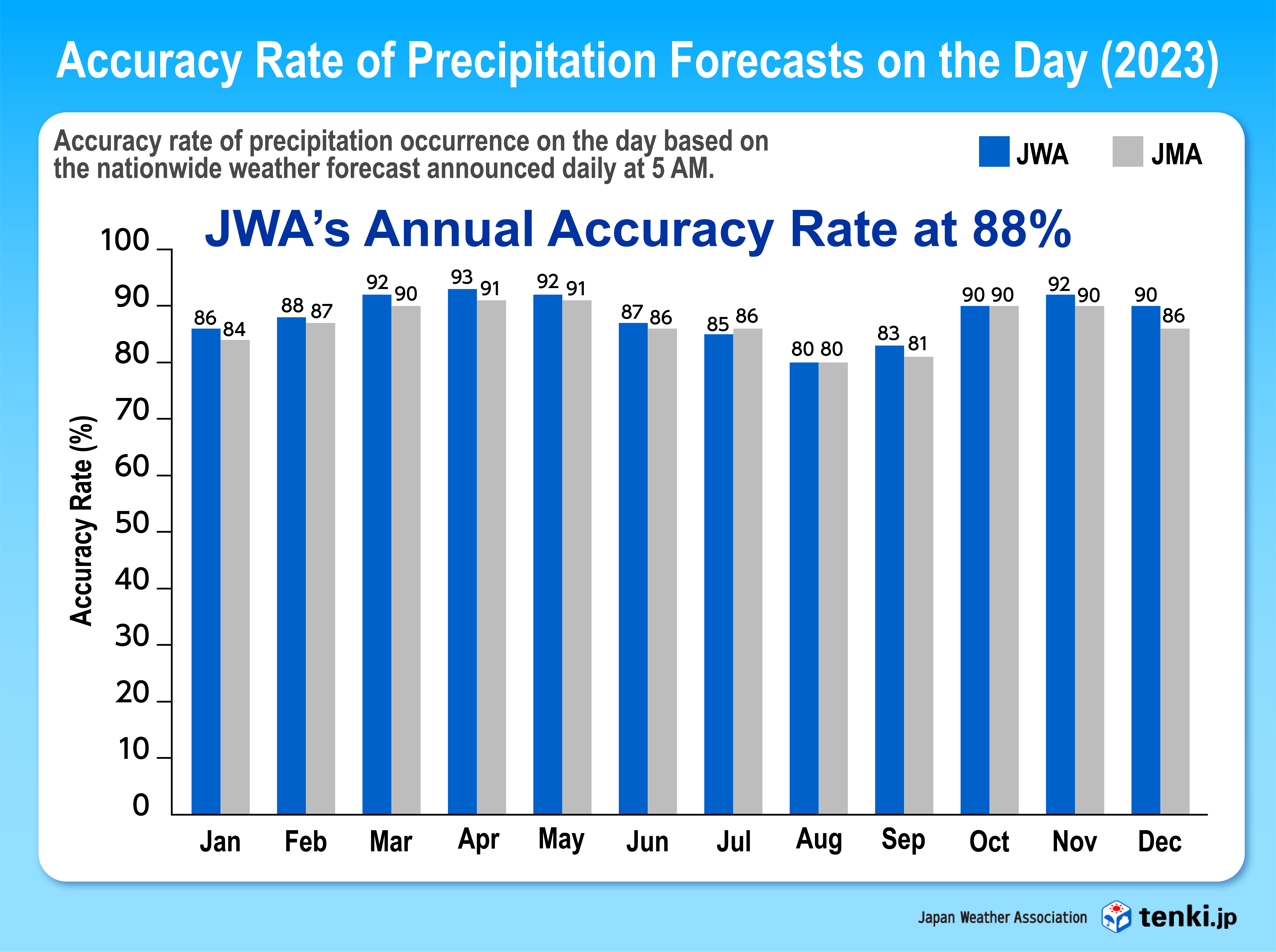News
2023 Japan Weather Association’s Forecast Accuracy Verification Results
2025.03.10
JWA, guided by its corporate mission of “Creating a society harmonized with the natural world”, promotes efforts by leveraging the “Power of Weather” to address societal challenges and create new value.
High accuracy weather forecasting is the key to creating benefits for people and society with the ‘Power of Weather’.
In 2023, JWA developed the integrated weather forecasting model “JWA Blend of Models*”, providing high-precision, high frequency, and high resolution forecasts for its various weather services.

* For more information about “JWA Blend of Models,” please click here: JWA Blend of Models (only available in Japanese)
2023 Forecast Accuracy Verification Results
Methodology
- Period: From January to December 2023
- Used Forecasts: Nationwide weather forecasts announced at 5 AM every day
- Method: This analysis focused on whether rain actually occurred on days it was forecasted.
It compared the “accuracy rate of precipitation occurrence on the day based on the forecast announced at 5 AM” (hereafter referred to as “accuracy rate of precipitation forecasts on the day”) between JMA and JWA predictions.
Results
“JWA Blend of Models” achieved an accuracy rate of 88% for the “accuracy rate of precipitation forecasts on the day” throughout 2023.
When compared to the JMA’s monthly accuracy rate for the same metric—calculated using the same criteria and publicly available—the accuracy rate of “JWA Blend of Models” was equal to or higher than JMA’s in 11 out of 12 months, except for July.

Calculation Method for the “Accuracy Rate of Precipitation Forecasts on the Day”
Based on the weather forecast verification indexes established by JMA, the presence or absence of precipitation in the forecast is compared to observations to determine whether the forecast was accurate or inaccurate, and the results are then aggregated.
Forecasts and Time of Day for Verification
- Time of forecast announcement: 5 AM
- Time period for observation verification : 5 AM to 12 AM on the day of the forecast
Locations for Forecast and Observations
- Observations: AMeDAS locations (approximately 600 stations) within the primary subdivisions where the announcing government office is located.
- Forecasts: Forecast Locations in the “JWA Blend of Models” that correspond to the AMeDAS locations used for observations.
Evaluation of Precipitation Presence or Absence
- Precipitation Presence: Precipitation amount of 1mm or more
(0.5mm or more for snow starting from October 2024 onwards) - No Precipitation: Precipitation amount of less than 1mm
(less than 0.5mm for snow starting from October 2024 onwards)
Contingency table for comparing forecasts and actual conditions
| Forecasts by “JWA Blend of Models” | ||||
|---|---|---|---|---|
| Presence of Precipitation | No Precipitation | Total | ||
| Actual conditions at AMeDAS locations | Presence of Precipitation | A | B | N1 = (A+B) |
| No Precipitation | C | D | N2 = (C+D) | |
| Total | M1 = (A+C) | M2 = (B+D) | N = (A+B+C+D) | |
N: Total number of forecasts
The accuracy rate is the ratio of the total number of correct forecasts to the total number of forecasts during the period, calculated as follows:
Accuracy Rate (%) = (A+D) ÷ N × 100
Target Period
- From January 2023 to December 2023, on a monthly basis.
* For detailed information on the verification method, please refer to the Japan Meteorological Agency’s Precipitation Verification (Only Available in Japanese).
Evaluation of Forecast Accuracy and Use of Accuracy Indicators
The “accuracy rate of precipitation forecasts on the day” used in this verification evaluates whether total precipitation of 1mm or more occurs between 5 AM and 12 AM on a given day, based on the forecast issued at 5 AM.
Therefore, even if the timing of rainfall at a certain location differs between the forecast and the observation, as long as it rains (or does not rain) at some point during the day, the forecast is considered accurate. This means that this indicator tends to yield higher accuracy results.
At JWA, we believe that accurate forecasts should not only predict whether it will rain at some point during the day at a specific location but also provide precise hourly forecasts, such as “if rain is predicted to start at 2 PM, it should actually begin at that time.” JWA is committed to improving forecast accuracy.
* For more information about JWA’s forecast technology, please click here: TECHNOLOGY
Weather Forecast Services by Japan Weather Association
Weather is one of the few areas where future conditions can be predicted using physical models. This predictive ability is highly valuable for business as weather impacts many industries. It’s estimated that one-third of all global industries face weather-related risks*1, highlighting the strong link between weather and business.
Introducing services that leverage JWA’s continuously improving weather forecasts for business applications.
- Weather Data API
JWA’s Web API provides access to both weather forecasts and historical weather data.
By obtaining weather data via API, you can make use of it in a variety of ways, such as displaying it on apps and web services, analyzing your own data with weather data, and building forecast models. - Product Demand Forecasting
By analyzing highly accurate weather forecast data and product data, JWA predicts future demand.
With precise product demand forecasting, businesses can take approaches that do not only rely on experience or intuition to increase sales and reduce costs.
For inquiries, contact us.
*1 Dutton, J. A., Bull. Amer. Meteor. Soc., 83, 1303-1311 (2002)